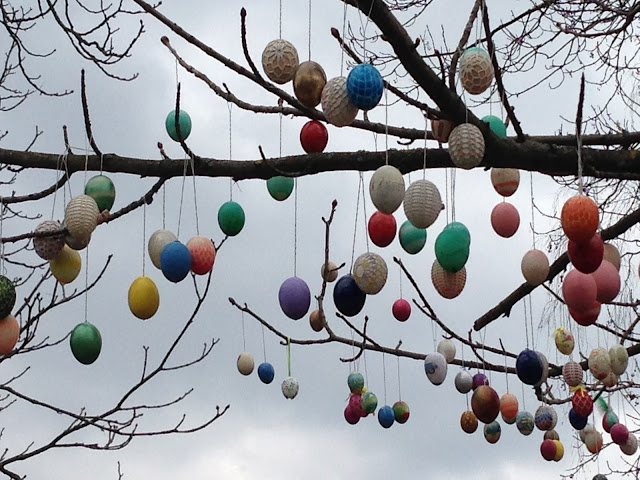Good Friday: Saalfeld & Potsdam
Since the office was closed for the Easter holiday on Good Friday, and Monday, we decided to take advantage of the 4 day holiday weekend. Early Friday morning, we left for Berlin.
Driving in a car allows us to see the scenic countrysides: rolling hills & green fields, trees & vineyards, the starting of yellow raps fields, white tarps covering asparagus so it will stay white and become spargel, very orderly stacks of wood, no farm animals in the fields (kept in barns or pens near the houses), stores and businesses were closed (because of the holiday), Easter decorations in yards and town squares (even one decorated bale of hay), and the increased number of wind turbines along the road as we go north.
E/S Rueckert (Self Reliance) rode with us; a 5 hour drive is a good opportunity to become better acquainted. Two other couples went in another car, E/S Hawkins (accounting & mental health), and E/S Piepgrass (medical).
Driving in a car allows us to see the scenic countrysides: rolling hills & green fields, trees & vineyards, the starting of yellow raps fields, white tarps covering asparagus so it will stay white and become spargel, very orderly stacks of wood, no farm animals in the fields (kept in barns or pens near the houses), stores and businesses were closed (because of the holiday), Easter decorations in yards and town squares (even one decorated bale of hay), and the increased number of wind turbines along the road as we go north.
E/S Rueckert (Self Reliance) rode with us; a 5 hour drive is a good opportunity to become better acquainted. Two other couples went in another car, E/S Hawkins (accounting & mental health), and E/S Piepgrass (medical).
We first stopped in the village of Saalfeld in order to see the famous Easter Egg Tree. We are standing in front of Schloss Saalfeld, showing a bit of spring complete with ducks and swans. A schloss is a castle meant to be a home.
Easter Egg trees are a German tradition. The one in Saalfeld was started many years ago by a German family. They blew the fresh eggs, decorated them, adding more each year until there were 10,000 eggs on it! It was quite a project to prepare the eggs, decorate the tree, take them down, and pack them for storage. The couple is well into their senior years so 2015 was their last year. They decided to let someone else take over and donated it all to the city.
This tree is in the Schloss Park; from a distance it looked like other trees in bloom. Even though it was a bit rainy, people were enjoying the Easter festivities.
They are all real eggs which have been blown and decorated in quite a variety of ways: painted, crocheted, covered with chips of glass, glitter, beads, anything the imagination can conjure up!
Continuing on our journey, we drove to the city of Potsdam to see Sanssouci Park, a large area which includes quite a large group of houses and gardens.
The main feature is the palace, built in the 18th century as a summer residence for Frederick II, one of the most remarkable kings of Prussia. They had so many guests that another palace was built to accommodate them. In 1990 the extended gardens and property were admitted to the UNESCO World Heritage list.
Here's the front of Sanssouci Palace.
The back of the palace.
The gardens must be very beautiful in the summer, but considering how many people were visiting today in the rain, it would be very crowded. Around the pond we see tall, skinny structures which we realized were meant to cover statues for the winter.
There are only 12 rooms inside, but they are large. Art pieces were done by Italian, French, and Dutch painters. The walls were covered with silk fabric.
In the time of forced marriages, he did not live with his wife.
We had to buy a special permit in order to take pictures inside the palace.
In 1886 this became one of the first palace museums.
In the Voltaire Room, the walls were decorated with flowers, fruits, vegetables, all grown on the grounds. The King's favorite was the cherry, for which he was prepared to pay handsomely because he believe the juiced would cure his gout.
The bookcases were made very low because the king was only 5'2" tall. He had 1000s of books.
Music was an important part of his life; he wrote 120 flute concertos and performed on flutes made especially for him. His teacher was the only one who could criticize him, and this was done by lightly coughing during a performance.
This piano was once played by one of Johann Sebastian Bach's sons.
Recessed bed in a guest room. There were so many visitors that a new palace was built to accommodate them.
Sunshine does make it look much nicer!
"Friedrich der Grosse"
On Easter Sunday we enjoyed meetings with Church members in the Berlin Tiergarten Ward who had interpretation ready for us. The first thing we noticed as we sang the opening song was that they had the "singing-est" chorister we'd ever heard...obviously an opera singer! As part of the Easter program, she sang a special musical number with a very talented flautist (whom I'm guessing was not a member).
We met Jenny Litster afterwards and learned that she is an American who got her start at BYU and knows our friend, Chris Holmes. She is living alone in Germany, but happy as long as she is being paid to sing.
To be continued: "Easter" Berlin















No comments:
Post a Comment